I had a plan for the Louvre Museum in Paris. According to the museum’s website, nearly six million people each year view some of the 35,000 works of art displayed in its 652,000+ square feet of exhibition space. Because most of these six million want to see the museum’s most famous lady, the Mona Lisa is surrounded by crowds much of the time. Like everyone else, I wanted a first-hand view Leonardo da Vinci’s masterpiece, but I hate crowds. Even the thought of being trapped in the midst of a jostling, jockeying throng, bombarded on all sides by people’s energy, makes me positively ill. Hoping to avoid the cattle call, I opted to leave the lady with the enigmatic smile for last, right before closing time.
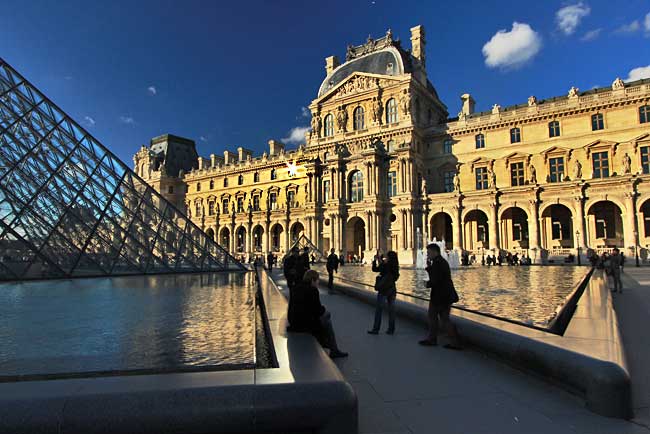
Inside the famous glass pyramid I descended to the main entry hall, already choked with tourists at 9 a.m. Hastily, I grabbed a map and fled into the Denon Wing on the lower ground floor, which was strangely bereft of traffic. At the end of a long gallery filled with Northern European Sculptures I came face to face with Saint Mary Magdalene, a unique early 16th century wood sculpture finished in polychrome. According to legend, Mary Magdalene was a repentant sinner who lived a life of seclusion in the cave of Sainte-Baume, clothed only by her hair. Every day the angels raised her up in the sky to hear the heavenly chorus.
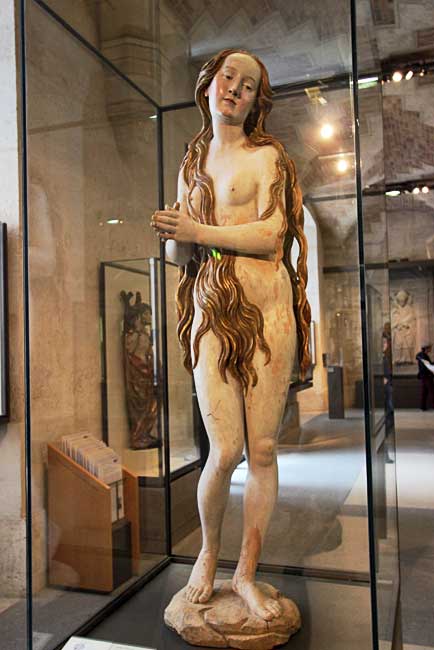
Awed by the 500-year old Lime tree wood carving, I circled the glass display case, examining every detail. Eschewing the Gothic tradition of thin, unreal figures, master sculptor Gregor Erhart endowed Mary Magdalene with voluptuous dimensions preferred by the emerging Renaissance movement. Originally held up by carved angels, the sculpture was part of a retable that is thought to have been suspended from the vault of a church in Augsburg, Germany. At some point, the sculpture was taken down and the angels were removed. Now separated from her heavenly entourage, the figure exudes a sensuality that is hard to reconcile with the image of a mystic ascetic. From the lifelike flesh tones of her nude body to the flowing locks of hair that cascaded to her thighs, she was magnificent.
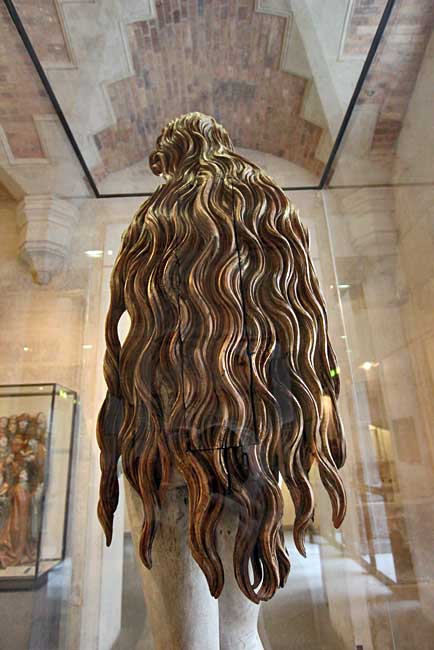
After an hour of educating myself about 12th to 16th century sculpture I left the almost deserted hall and headed for the adjoining Islamic Art exhibit that opened in September of 2012. Here I discovered more breathtakingly beautiful objects, including the Baptistère de St.Louis, a hammered brass basin, engraved and decorated with inlaid silver, gold and black paste. The exterior of this masterpiece, crafted in Syria or Egypt between 1320-1340, is decorated with a series of figures carrying bows, maces, or swords, heading toward a hunter king. Inside the bowl, hunting and battle scenes alternate with an enthroned king. The name of the vessel derives from its use in the baptism of Louis XIII in 1601, and its association with King St. Louis from 1742 to 1791.

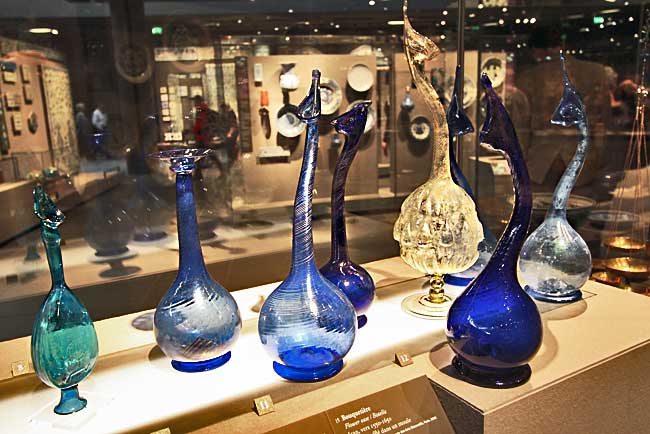
The gallery of Islamic Art displays 3,000 objects from the Louvre’s 14,000 piece collection. Pieces date from the dawn of Islam in the 7th century to the early 19th century and include architectural elements such as an intricate mosaic floor, precious weapons from India, glassware manufactured in Iran, stone and ivory objects, metalwork, ceramics, textiles and carpets, and even manuscripts. I wandered through this uncrowded gallery for for more than an hour before making my way to see another of the Louve’s other famous masterpieces, Aphrodite, better known as the Venus de Milo.
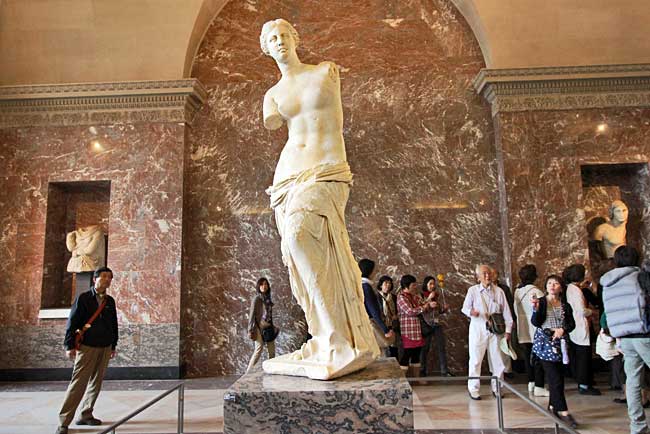
Like the Mona Lisa, which has for centuries engendered theories about why she smiles, Venus de Milo is shrouded in mystery. Discovered in 1820 on the island of Melos, Greece, she was carved from two different blocks of marble. The bust, legs, left shoulder and foot were sculpted separately and affixed to the main body with vertical pegs, but her arms were never found. She may have been leaning against a pillar or resting her elbow on someone’s shoulder. If she held a bow or an amphora, she was Artemis or a Danaid. She could have held an apple, crown, shield, or a mirror, all of which are symbols of different goddesses. Due to her sensual curves and half-naked state she has come to represent Aphrodite, but she could just as easily be the sea goddess Amphitrite, who was venerated on the island of Milo.
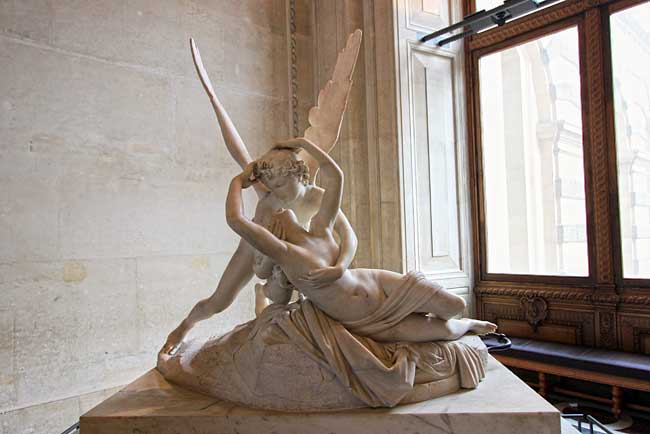
By now I was in the more popular galleries, fighting my way through hundreds of school children on field trips and young artists slouched over sketch pads, reproducing the most famous works of art. Exhaustion was setting in, but there was so much more to see. After a brief stop at the tender yet erotic Psyche and Cupid sculpture by Antonio Canova and Michelangelo’s Captive (The Dying Slave), I crossed over to the Richelieu wing in search of The Law Code of Hammurabi. This stele, erected by the king of Babylon in the 18th century B.C., is inscribed with almost three hundred laws and legal decisions governing daily life in the kingdom of Babylon. Not only is this work an exceptional source of information about the society, religion, economy, and history of this period, it has also served as a template through the ages as modern law evolved.

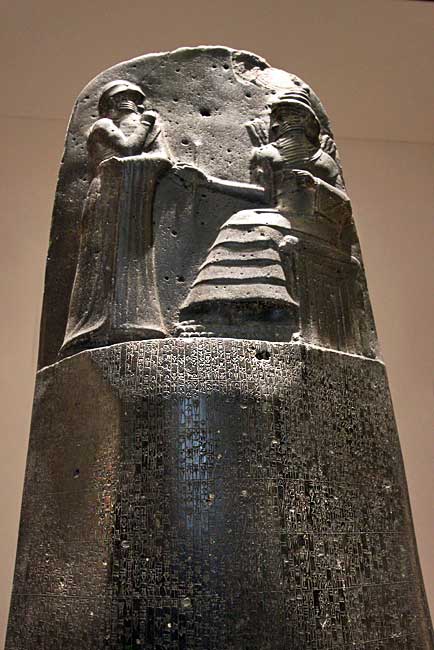
The lack of daylight in a hallway window and my aching feet both told me it was finally time to hunt down the Mona Lisa. I made my way to the painting gallery and wriggled through a small crowd still clustered around da Vinci’s masterpiece. And there she was: a tiny, dark and dreary portrait. I was underwhelmed. The history of the Mona Lisa remains shrouded in history to this day. No one knows who sat for the portrait, who commissioned it, how long da Vinci worked on it, or how it came to be in the French royal collection, but for me her enigmatic smile is no longer a mystery. Thousands of exquisite works of art in the Louvre are more beautiful and historic than the Mona Lisa, yet she remains the museum’s number one draw. I’d be smiling, too.

Visiting the Louvre Museum in Paris, France
Getting there: The Louvre is easily reached by the Paris Metro; exit at Palais Royal-Musée du Louvre on lines 1 and 7.
Hours: The museum is open every day except Tuesday and some public holidays. Hours are from 9 a.m.to 6 p.m.; open until 9:45 p.m. every Wednesday and Friday.
Information desks: Beneath the Pyramid and at the Portes de Lyon entrance. Telephone: (0) 1 40 20 53 17 (country code +33)
Tickets: Valid for entry all day, last ticket sold at 5:15 p.m. (9:15 p.m. on Wednesdays and Fridays). Full price €11 (about $15 USD); exhibitions in the Hall Napoléon €12 (about $16.25 USD); combined tickets €15 (about $20.60 USD). Upon presentation of the appropriate supporting documentation, admission is free for young people under 18, job seekers, disabled visitors and one accompanying person. Admission is free for EEC citizens under 26 and practicing teachers. Visitors with tickets purchased in advance do not need to wait in line. Reservations can be made by visiting www.louvre.fr. Admission is also free for everyone on the first Sunday of every month.
Services: Cloakroom, lockers, and wheelchairs are available at no cost. Cafes, cafeterias, and restaurants are available on site. Restrooms are available throughout the museum.
Visiting Rules: Photography, without flash, and filming are permitted in the permanent exhibition areas. Photography and/or filming is not allowed in the temporary exhibit areas. Use of mobile phones, smoking, eating, drinking, loud discussions, touching the collection, and running are all expressly prohibited.
Author’s note: If you’re considering a visit to Paris, my favorite site for finding the best prices on accommodations is Booking.com. I earn a small sum if you book by clicking on this link to accommodations in Paris, which helps keep this blog free for you to read.

I thought I had seen pretty much everything in the Louvre, but I absolutely didn’t see the lush hairs of St. Mary Magdalene’s ;-)!
I do agree with your take on the Mona Lisa though. I like the other works of Leonardo Da Vinci more, and they are also portrayed in the Louvre. Only with a lot less visitors surrounding it!
Amen to that Sam!
I barely broke stride as I walked past the little glass case on the wall surrounded by a crowd of people. I appreciate what David offers re the ‘story’ behind the Mona Lisa. You can look at just about anything and find it becomes more interesting knowing its ‘story’, historically, culturally, artistically, whatever. Even if, like me, you don’t remember much of the story later, it can be well worth the effort to do a little homework beforehand (which, by the way, I am also not very good at).
Hi Kevin: You’re probably right, but in this case I have to believe I would still have found he Mona Lisa underwhelming, simply because Leonardo DaVinci did so many other astounding things.
Again, a fabulous piece of writing. I love the Louvre and its exhibitions, but as most here, I was disappointed with “la Giocondo”, probably most by the smallness of the painting. As David mentioned, it looks much better on paper. But other then that, the Louvre is always worth my time.
Hi Fida: I only saw perhaps 60% of the exhibits – the Louvre is so darned big! So I’ll definitely have to go back the next time I’m in Paris, but at least I won;t be wasting time on our friend, Mona. Glad you liked the article; appreciate the compliment.
Well, actually, I feel as if you transported me there, so I don’t need to bother! When I went to Paris (just once) I wasn’t in company which wanted to see museums and art galleries. I was granted my one wish which was to see Les Invalides, because Napoleon had, for some reason, been my hero when I was quite young!
Gorgeous photos – and at least they do allow them – looking at the Venus de Milo made me remember how extraordinary it often is (though obviously not in the case of the Mona Lisa) to see something that famous, of which you’ve been seeing pictures all your life.
Hi Linda: I will say that all the other famous works of art totally lived up to their reputations; it was only Mona who disappointed. Hope you get to visit the Louvre the next time you’re in Paris.
I can’t stand crowds. I agree- the Louvre is full of amazing treasures – see those!
I think I could return again and again and never see the same thing twice. So much of the displays came under the heading of “amazing” and I don;t use that word lightly.
I visited the Louvre when I was 14 on my first overseas trip, so I hardly remember a thing. I’d love to go back and see some of the gorgeous art you photographed. I do know I saw the Mona Lisa that day, and I do remember thinking how small it was, so I’d probably be fine skipping it altogether on a future visit to the museum.
There’s SO much to see, Ali. I barely made it through half of the museum. Next time, I doubt there will be any reason to see the Mona Lisa.
I also wondered what all the fuss is about. The painting is surprisingly small and always surrounded by crowds. The lOuvre is so big, I prefer the more accessible Musee D’Orsay where you can see all those lovely impressionists
I’ll have to put the Musee D’Orsay on my list for my next visit, Heather – thanks!
Well, it seems to be a consensus, doesn’t it? Small, hard to see clearly, enigmatic and all that, basically famous for being famous. Maybe that’s one (of many) reasons why I couldn’t stand the “Da Vinci Code” and all the furor and hype surrounding it, as well.
Funny, Greg, but before I went to the Louvre I thought about The Da Vinci Code, but once there I forgot all about it. The art at the Louvre just transported me to another place, I guess, that wasn’t worth trite fiction.
I smile too and agree with you. I have seen Mona Lisa, but the copy (the same age) in Prado Museum in Madrid is much more better 🙂
Hi Victor: I had no idea there is a copy in the Prado. Was it painted by one of da Vinci’s apprentices. Wonder what it’s provenance is?
I was very disappointed when I saw the Mona Lisa for the first time. I felt cheated. I loved everything else in the Louvre, but I still don’t get why all the fuss about her.
Hi Cristina: Thanks – I was a little worried about what I said but so far, no disagreement.
I loved this article! It reminded me of my first visit to the Louvre – many years ago, when it was free on Sundays, and packed with groups of students and coach-loads of tourists – and how terribly disappointed I was by Mona Lisa. I had imagined something far grander and impressive and there she was in a tiny bullet-proof glassframe which reflected the light so much you could hardly see her, and when I did, I wondered why I had risked being trampled to death by hordes of Japanese art students. The Cluny Museum and Rodin museum were a source of peace and beautiful memories. Thank you for sending me back down memory lane.
Hi Vicky: I never thought about it being bullet-proof glass but that makes so much sense. Ijust thought it was dirty glass or fogged up plexiglass and I wondered why they couldn’t keep it cleaner.
Everytime I visit a museum, and even see these photos, I am amazed that all of these items were able to last so long. With so many wars, fires, and everything else over the human lifetime, it’s just boggling to me to be able to see these amazing relics. Nice write-up and synopsis on the Mona List smile.
Hi InACents: Absolutely! I also thought it was a miracle that some of these pieces survived.
I similarly planned, arriving early and racing straight to the Mona Lisa before starting a more civilised viewing of the gallery. The collection is overwhelming in its scale and quality. I was also underwhelmed by Mona (maybe it size was part of the reason) despite being a huge fan of Leonardo (his genius still amazes me). His other Louvre paintings are much less viewed as are nearly all the other painting, sculptures, etc. One of the art-work’s strange enigmas.
Seems to be the consensus, Mark, so looks like we’re not alone 🙂
I did the Louvre after days of seeing other museums. By time I made it through all the sculptures, Islamic art, etc., I was overdone on paintings. And by the time I finally reached La Jacand, I verbally said “Is that really it!” LOL
Glad you agree with me Talon – just had to see it but I’ll skip it next time.
Exactly my own sentiments! I first saw the Mona Lisa in the 1980s and heard a man next to me laugh as I inadvertently said aloud, “I stood in line for that long for this?” In contrast to many of the other works of art on display, I found the Mona Lisa quite unimpressive.
Hi Deborah: That seems to be the consensus, doesn’t it? Makes me wonder how it ever got so famous in the first place.
The problem (see the consensus here) is that because it is so famous, people have all of those fantasies about it, which cannot not lead to disappointment (especially in the way it is presented, in the very middle of that large room and such).
Truth is, it is a fascinating piece for so many reasons (but historical and artistic), and it’s basically always been famous. Why? Well, the mystery of her identity is part of it (although while cannot be proven, the identity is not a huge mystery, especially with her full name: Mona Lisa del Giocondo http://en.wikipedia.org/wiki/Lisa_del_Giocondo ), its history: Leornado brought it with him to France when he left Italy (when he left behind way more important works, why?), of course the smile (if the painting is so dark, it is because she is mourning – see the clothes too – so why that smile. Finally, in the age of photography, we must not forget when this painting was made. It is one of the very first paintings of someone to be so realistic. The composition is also fascinating, it really has some depth very few paintings had at the time (once again in the age of 3D one doesn’t pay attention to that anymore, but back then) Etc.
It is indeed a fascinating piece, but once again, when one goes see it just because it is famous, one does not see those considerations and one will be disappointed.
Hi David: Thanks for that bit of history: “Leornado brought it with him to France when he left Italy (when he left behind way more important works, why?)” That makes the painting more mysterious, which makes the fact that it is so disappointing even more puzzling.
I had exactly the same feeling about the Mona Lisa. First thing I thought when seeing it was: “Is that it?”, follow by “It’s so small!”. I didn’t particularly like it. As you say, there are so many more beautiful and intriguing works of art to be seen at the Louvre.
Hi Sofie: I had the same exact thoughts when I got my first glimpse, followed by “It’s so dark and dingy.” The Mona Lisa almost looks like she needs a good cleaning.
The Mona Lisa is famous because she’s famous because she’s famous basically.
It’s the good old tourist cliché that when you go to Paris, you HAVE TO see Mona Lisa, the Eiffel Tower and others. And not venture in unknown parts of town. Most people don’t travel to discover new things anymore but to go see what they already know and have already seen countless times before except not “for real”.
Mona Lisa is in my eyes the perfect example of this absurdity, when many visitors of the Louvre will basically not care for anything else (because they don’t care about historical art). But ironically, the best way to enjoy Mona Lisa is in a book, on a high resolution picture on the web or whatnot, but definitely not in front of the “real” one. Is it even the real one? Does it matter?
That being said, I’m glad you spent time in the less crowded parts of the Louvre (which also happen to be my favorite ones). I remember back in the days when I lived in Paris and had free entrance at the Louvre (you can be jealous), some days, when I have time to kill and I was in the neighborhood, I would just go for a stroll there, because there are worse place to have a stroll.
Hi David: You’re absolutely right. In the end, the wooden carving of St. Mary Magdalene, hidden in the far corner of the lowest level of the museum where hardly anyone else had ventured, was my favorite piece of the day.
Some great pieces of art there, loved those glass vases. Personally, I would’ve skipped the Mona Lisa, never figured out what was so special about it.
Hi Faisal. LOL. Had I known, I would have skipped the Mona Lisa myself. But I got a good laugh out of how underwhelming she was, after all the hype.
I’m glad I’m not the only one who feels that way, I was expecting angry replies to my comment 🙂
Awesome photos! I was at the Louvre about three years ago, and it was packed.
It was pretty packed when I was there, too Jam. But I ditched the crowds by visiting some of the less popular galleries and in the end those were the places where I found the pieces I liked the most.